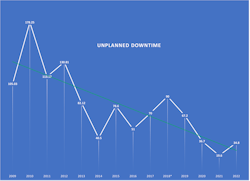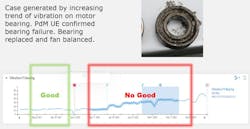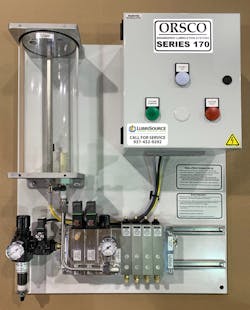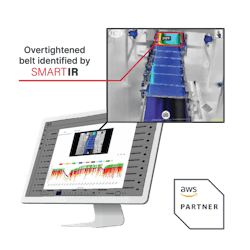Mechanical and electrical equipment in industrial facilities naturally experiences wear due to heavy use and often grueling conditions. Avoiding premature asset failure and unplanned downtime is a vital responsibility, and well-equipped maintenance and reliability teams are up to the task.
Modern predictive and prescriptive maintenance tools allow essential personnel to identify emerging issues early enough to address them during scheduled maintenance outages, avoiding costly downtime and improving safety, reliability, and operational performance. Some tools even prescribe or apply corrective actions. What’s more, the available tools, technologies, and methods are improving and expanding at an unprecedented rate.
Ramesh Gulati, Reliability Sherpa at ReliabilityX, has witnessed significant advancements in predictive maintenance technology over the years. He recalls the early days of his maintenance-reliability career when basic tools like a screwdriver (to tighten screws but also to listen to components such as bearings for their condition), a level gauge (to measure machine surfaces), a ruler (to measure straightness), and a coin (to measure vibration/displacement) were the primary predictive tools.
“Thanks to the evolution of computer technology and the miniaturization of electronics, predictive tools like laser alignment tools, infrared cameras, ultrasonic guns, etc., have become readily available, easy to use, and affordable,” says Gulati. “Recently, motion amplification cameras have been added to our toolbox, allowing us to see vibration visually. Smart sensors capable of measuring multiple parameters, communicating with each other, making necessary adjustments, and issuing work orders for human intervention when required are also emerging in the market.”
Below are eight solid examples of how industrial organizations are gaining value from predictive maintenance, and the impressive variety of predictive and prescriptive technologies being used to achieve reliability goals.
1. Ingredients manufacturer
Allen Welter, reliability manager at Rousselot Dubuque, shared highlights of his team’s reliability and KPI improvements in a presentation at the 2023 Leading Reliability conference about the impact of ultrasound technology on plant success. Rousselot is a Darling Ingredients company.
In 2012, the Dubuque, IA, plant chose ultrasound as its first predictive maintenance technology. Today, with a “complete arsenal” of ultrasound equipment, ultrasound remains at the core of a global approach to maintaining equipment reliability (see Figure 1).
Welter observed that from 2019-2022, the total estimated cost avoidance directly attributed to the plant’s four fully developed ultrasound programs was $1,939,306, including:
- $544,234 from mechanical condition monitoring: Detecting bearing lubrication issues and validating vibration issues with ultrasound led to 34 failures being detected and repaired, 42 hours of downtime avoided, 109 lubrication saves, and 17 other issues corrected.
- $34,500 from steam trap condition monitoring: Using ultrasound and infrared together, 23 steam trap failures were detected and repaired.
- $1.2 million from electrical condition monitoring: A single ultrasound finding, an arcing and tracking situation with one of the primary service breakers, led to this conservatively estimated savings.
- $160,572 from compressed air condition monitoring: Using ultrasound, 284 compressed air leaks were detected, measured, and repaired.
Furthermore, with the new UltraView Camera from UE Systems added to their toolkit this year, the average number of air leaks discovered per route increased more than 400% from January to April 2023.
2. Automaker
David Ammons, maintenance senior manager at Nissan’s Canton Vehicle Assembly Plant, presented the plant’s condition-based maintenance and continuous monitoring strategy at the 2023 MARCON conference, hosted by the UT Reliability and Maintainability Center. Selected examples of effective savings from failure prevention by continuous monitoring at the Canton, MS, plant include:
- Current and voltage monitoring exposed a motor current anomaly, causing Senseye Predictive Maintenance from Siemens to trigger a case. An inspection found that a turn wheel had seized up and was not rotating, which was corrected.
- Vibration monitoring uncovered increasing vibration in a motor bearing, which triggered a case (see Figure 2). Bearing failure was confirmed by ultrasound so it was replaced, and the fan was balanced.
- Torque monitoring revealed a sudden shift in the measured maximum torque percentage in a robot axis, which triggered a case in time for corrective action.
- Cylinder shift time monitoring exposed an increase of cylinder shift time for a poppet closing, which generated a case. It was determined that the cylinder closed limit switch had loosened and moved, and corrective actions were taken.
- Temperature monitoring detected a VFD cabinet’s temperature was above the threshold, triggering a case. The investigation revealed that the cabinet fan had been disabled. Re-enabling it returned the temperature to normal.
Ammons added that across fiscal years 2021-2022, the plant’s continuous monitoring strategy prevented a minimum of 17 major breakdowns and avoided nearly 66 hours of unplanned downtime, saving millions of dollars.
3. Chemicals manufacturer
SCG Chemicals, one of the largest petrochemical companies in Thailand, embarked on a digital transformation initiative to achieve “zero unplanned downtime” by predicting and avoiding equipment failures.
A new Digital Reliability Platform (DRP) was developed in partnership with AVEVA for end-to-end visibility of plant operations (see Figure 3). Key components include AI-based predictive monitoring, analytics, and prescriptive recommendations; enterprise asset management software; a centralized data management platform called the Digital Reliability Center; and a virtual 3D plant.
SCG identified primary areas of business value from the solution:
- Plant reliability increased from 98% to nearly 100% through catch identification to avoid asset failure.
- Avoiding asset failure costs yielded 9x ROI.
- Maintenance costs decreased by 40% through greater operational and workforce efficiency and improved work scheduling.
- Planned maintenance costs decreased by up to 30% through the use of data from IIoT sensors and real-time analytics.
- The time to retrieve actionable information was reduced to less than 10 seconds through the single source of truth, single data platform, and automated reporting.
DRP’s five-month pilot and ensuing success prompted SCG Chemicals to scale up the DRP to its 15 plants and its joint ventures.
4. Steel processor
A global metals manufacturing company, Worthington Industries, began a journey in 2017 to improve overall plant reliability starting with one Columbus, OH, facility. Today, it has 17 steel processing and pressure cylinder facilities across North America proactively managing assets with remote condition monitoring and predictive maintenance (see Figure 4).
Using Vero wireless sensors from AssetWatch (formerly Nikola Labs) and its cloud-based, AI-powered software platform, anomalies are detected, risks are prioritized, and prescriptive insights are provided to the plants for timely corrective actions.
Presently, more than 650 critical machines are monitored with more than 1,800 rugged sensors collecting full-spectrum vibration and temperature data. In total, more than eight million data points on assets such as motors, bearings, pumps, fans, and gearboxes have been analyzed by machine learning and certified condition monitoring engineers.
The 24/7 monitoring and early insights from AssetWatch enable the plant maintenance and reliability teams to take proactive steps to improve machine health and uptime. Reported gains since install of the technology and service solution include:
- $16 million potential lost gross margin was saved.
- More than 400 prescriptive maintenance recommendations were issued.
- More than 260 downtime risks were resolved.
- At least 10x ROI was realized.
The proactive maintenance strategy, based on predictive maintenance and condition-based monitoring, is continuing to deliver significant gains.
5. Gas processor
The Houston, TX, site of an international gas processor manufactures liquid air, a process that involves operating multiple O2 compressors. Availability and reliability of the compressors is essential to ensure safety and preserve the production schedule. To predict issues and avoid future failures, a vibration condition monitoring plus protection solution was created by Emerson and impact partner Puffer-Sweivan for three critical O2 compressors at the plant.
The solution includes six accelerometers and an eddy current phase probe. The sensors deliver data to a machinery protection system with prediction capabilities. Output is then sent to a distributed control system (DCS), machinery condition monitoring software, a historian, and an external prescriptive analytics package. A mobile app provides visibility to analysts from any location.
PeakVue technology reveals data trends and provides early warning of issues, while also simplifying data interpretation so that operators, not vibration experts, can understand what a vibration condition may require—whether lubrication, bearing replacement, or otherwise.
Reported results from the vibration condition monitoring solution include:
- $2 million in savings were gained from averted production losses.
- $1.5 million in cost reductions were realized from preventing repeated failures.
- $1.5 million in material savings were attained from avoiding replacement of compressors and vibration switches.
The benefits of vibration monitoring can extend across sites and to the balance of the plant. The long-term goal is to bring all compressor data to the Enterprise Monitoring Center in Houston.
6. Food and beverage manufacturer
A well-designed chain lubrication system is a valuable precision maintenance tool. But an oil system used by a national food and beverage manufacturer in certain ovens was creating serious challenges. Spray nozzles would fail without warning, starving $80,000 oven chains of oil. Dry chains stretched under load would break, creating an average of 1.5 hours of production downtime and 8 hours of lost product per chain break.
The manufacturer asked LubriSource, a provider of advanced lubrication systems and services, to review the oil system. Its lubrication specialists found that the applicator wheel used to deposit the oil was designed for grease, not oil, causing extensive over-oiling and creating hazardous puddles and lubricant waste. The system also lacked adequate alarms.
LubriSource designed and installed an ORSCO Series 170 oil spray system (an SKF Lincoln brand) for controlled oil delivery (see Figure 5). Besides applying the correct amount of oil on the chain, it also alarms when the reservoir is low and when the spray nozzle is not oiling, enabling corrective actions to prevent failure. With this system, the manufacturer is increasing reliability and safety:
- Unplanned downtime and costs were avoided.
- Chain life was extended.
- Oil consumption was reduced.
- Slip hazards were eliminated.
- Maintenance efficiency was increased.
There are now four ORSCO units installed to protect oven chains at three of the manufacturer’s plants. “This company is going to replicate the solution across multiple lines and plants,” says Angela Morrow, president of LubriSource.
7. Mining company
A major mining company returning a factory back into operation sought to instill a culture of reliability and proactive asset and equipment management. In partnership with Spartakus Technologies, two predictive maintenance programs were instituted—first vibration analysis and then oil analysis—and the results were deployed in Spartakus APM, an asset performance management software platform.
As expected, the newfound visibility into vibration and oil anomalies created an initial flurry of maintenance activity. Many high-priority issues that had the potential to shut down the plant were revealed in the first six months. Once they were resolved, subsequent alerts were of a lower priority, making it possible to see emerging, potential failures much earlier and allowing for optimized predictive maintenance planning and scheduling.
The company is reaping the benefits of the proactive monitoring strategy and the continued presence of an on-site technician from Spartakus, including:
- 50% reduction in high-priority alerts in the first few months was realized.
- $4.5 million in savings were documented in 2 years.
- Unplanned shutdowns were avoided.
- Plant reliability continuously improved.
With the platform for intelligent, real-time, and risk-based reliability management and the ability to make data-driven decisions, the benefits are expected to continue accruing.
8. Distribution facility
A Fortune 50 online retailer and manufacturer was experiencing regular failures in its conveyance assets used to move and sort thousands of packages daily within its distribution facilities. Overall waste and lost productivity from downtime was measured in the hundreds of thousands of dollars, and the incidents continued despite using handheld infrared (IR) cameras in monthly inspections.
Upgrading its predictive maintenance strategy to include continuous thermal monitoring and automated alerts of temperature anomalies would help to identify more and earlier issues before failure (see Figure 6). The solution, initially deployed at one distribution facility, included three FMX 400 fixed-mount IR imaging cameras paired with SmartIR software from Infrared Cameras Inc.
Within the first month, addressing three imminent, critical failures found by SmartIR provided a positive ROI for the condition-based monitoring solution, including:
- $10,000 was saved by finding and repairing an overtightened belt that would have caused an unexpected failure and greatly shortened the life of the belt.
- $15,000 was saved by replacing a motor during scheduled maintenance that was above the expected temperature range.
- $10,000 was saved by repairing and realigning an angled induct belt that was starting to rub.
The customer has since socialized the solution internally to other facilities and engaged ICI to install SmartIR in their distribution facilities worldwide.
Today’s evidence hints at tomorrow’s potential
Innovations in predictive maintenance show no signs of slowing. For instance, with continuing advancements in computer technology and digitalization, Gulati expects that smarter sensors capable of performing multiple functions, providing more visualization, and having easier interfaces will become more reliable and affordable. “However, they will require more training and upskilling of our workforce to be widely accepted,” he adds.
Applying predictive and prescriptive technologies provides a tremendous opportunity to increase asset reliability and uptime, lower costs, and improve plant safety, throughput, and performance. What more could an industrial organization want?







